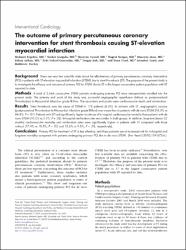| dc.contributor.author | Ergelen, Mehmet | |
| dc.contributor.author | Görgulü, Şevket | |
| dc.contributor.author | Uyarel, Hüseyin | |
| dc.contributor.author | Norgaz, Tuğrul | |
| dc.contributor.author | Aksu, Hüseyin | |
| dc.contributor.author | Ayhan, Erkan | |
| dc.contributor.author | Günaydın, Zeki Yüksel | |
| dc.contributor.author | Işık, Turgay | |
| dc.date.accessioned | 2019-09-02T06:34:50Z | |
| dc.date.available | 2019-09-02T06:34:50Z | |
| dc.date.issued | 2010 | en_US |
| dc.identifier.issn | 0002-8703 | |
| dc.identifier.uri | https://doi.org/10.1016/j.ahj.2009.12.032 | |
| dc.identifier.uri | https://hdl.handle.net/20.500.12462/6118 | |
| dc.description | Uyarel, Hüseyin (Balikesir Author) | en_US |
| dc.description.abstract | Background There are very few scientific data about the effectiveness of primary percutaneous coronary intervention (PCI) in patients with ST-elevation myocardial infarction (STEMI) due to stent thrombosis (ST). The purpose of the present study is to investigate the efficacy and outcome of primary PCI for STEMI due to ST in the largest consecutive patient population with ST reported to date.
Methods A total of 2,644 consecutive STEMI patients undergoing primary PCI were retrospectively enrolled into the present study. The primary end point of this study was successful angiographic reperfusion defined as postprocedural Thrombolysis In Myocardial Infarction grade III flow. The secondary end points were cardiovascular death and reinfarction.
Results Stent thrombosis was the cause of STEMI in 118 patients (4.4%). In patients with ST, angiographic success (postprocedural Thrombolysis In Myocardial Infarction grade III flow) was worse than in patients with de novo STEMI (76.3% vs 84.8%, P = .01). Patients with ST had significantly higher incidence of in-hospital cardiovascular mortality than patients with de novo STEMI (10.2% vs 5.3%, P = .02). In-hospital reinfarction rate was similar in both groups. In addition, long-term (mean 22 months) cardiovascular mortality and reinfarction rates were significantly higher in patients with ST compared with those without (17.4% vs 10.5%, P = .02 and 15.6% vs 9.5%, P = .03, respectively).
Conclusions Primary PCI for treatment of ST is less effective, and these patients are at increased risk for in-hospital and long-term mortality compared with patients undergoing primary PCI due to de novo STEMI. (Am Heart J 2010; 159: 672-6.) | en_US |
| dc.language.iso | eng | en_US |
| dc.publisher | Mosby-Elsevier | en_US |
| dc.relation.isversionof | 10.1016/j.ahj.2009.12.032 | en_US |
| dc.rights | info:eu-repo/semantics/openAccess | en_US |
| dc.title | The outcome of primary percutaneous coronary intervention for stent thrombosis causing st-elevation myocardial infarction | en_US |
| dc.type | article | en_US |
| dc.relation.journal | American Heart Journal | en_US |
| dc.contributor.department | Tıp Fakültesi | en_US |
| dc.identifier.volume | 159 | en_US |
| dc.identifier.issue | 4 | en_US |
| dc.identifier.startpage | 672 | en_US |
| dc.identifier.endpage | 676 | en_US |
| dc.relation.publicationcategory | Makale - Uluslararası Hakemli Dergi - Kurum Öğretim Elemanı | en_US |


















